- Saturday, June 14, 2025
- Stay Connected
 Abraham Lincoln
If given the truth, the people can be depended upon to meet any national crisis...
Abraham Lincoln
If given the truth, the people can be depended upon to meet any national crisis...
 Guildford news...
for Guildford people, brought to you by Guildford reporters - Guildford's own news service
Guildford news...
for Guildford people, brought to you by Guildford reporters - Guildford's own news service
Around The Very Top: A Cultural End
Published on: 9 Jun, 2015
Updated on: 10 Jun, 2015
Martin Giles is cycling around the top of northern Scotland with his son Tom. This is a report on the leg from Strathy to Thurso. Find other reports in the series by searching on: “Around The Very Top”.
Note: most images can be enlarged by clicking on them.
By Martin Giles
“You should go to the Broch museum at Auckengill and the harbour at Kiess is worth a visit,” this was the advice from Mark our John O’Groats host who hailed from Barnet but who now felt stressed if he travelled as far south as Perth.
Breakfast at the John O’Groats Guesthouse had lived up to expectations. Will you have some pancakes, everyone seems to like them,” said Mary, Mark’s partner. It seemed rude to refuse and they were very good.
The day started off a bit overcast and showery but soon brightened up. I wanted to finish a previous “cyclelogue” as one reader has accurately christened my articles, so I asked if we could stay in the dining room area for a couple of hours.
The answer was as I expected, “Of course, can we get you some tea, coffee…?” I suspect that if I had asked Mark and Mary to type my entry as I dictated they would have acquiesced, they really were so obliging. I hope no one does take advantage of their hospitality.
Eventually, I finished my article and off we set with our hosts’ fond farewells and best wishes echoing in our ears.
I was far windier than we had realised sitting in the guest hose’s comfortable dining room and it seemed to be coming up from the southwest, almost in our faces. We started with a longish climbing through the familiar heather bog land with the sea away to our left. The wind made the first couple of miles seem long but then the road dipped down for a long downhill stretch.
In front of us was a wind farm on what appeared to be an area of scorched earth. Given the strength of the wind I thought that the giant sails might detach themselves and start cartwheeling cross country. Come to think of it the engineering must have to be extremely robust for all the weather conditions possible, if not likely, in this part of the world.
Goodness knows now much energy the farm was producing: there was certainly plenty of energy to draw from in the air movement all around.
Even cycling downhill was a problem. The strong wind was buffeting us from the right and made the handlebars alive as the gusts kept battering us. Having stopped to wait for me, Tom was even blown off his bike at one stage – onto a soft grassy verge, luckily.
We kept going, what else could we do and as we descended we became more sheltered. At the bottom of the descent the road curved round to the left. The wind was now directly on our backs making the climb up the next hill noticeably easy.
The road now was a proper two lane A road and although some of the vehicles were travelling at speed they normally could see well ahead and gave us a wide berth. Traffic was pretty light so did not impair our enjoyment. The road was close to the coast and the sea looked very blue you could almost imagine it might be warm.
Another couple of miles and we were at Auckengill and the Caithness Broch Centre, housed, appropriately, in the former school where one of the main initial Broch investigators Joseph Anderson was himself taught. The museum was small but it is good not to be overwhelmed with information or exhibits and what was there was exhibited very well.
The brochs which I knew next to nothing about, proved to be fascinating structures built around the first century BC. They were circular towers with very small entrances and hollow walls and labyrinthine design.
These features together especially the narrow entrances must have made them difficult to attack but whether their main purpose was defensive is still a matter of debate. My guess, for what it is worth, is that it was, why else go to all that effort?
Their remains are concentrated in Caithness but are also found scattered in other coastal areas of Scotland. One definite requirement is a plentiful supply of the right type of stone.
We said goodbye to the rather lonely looking lady at the door, we were the only visitors at the time, and she confirmed the direction to Kiess harbour and said that there was a shop at the junction of the road we needed to take.
So it proved. The shop was not that well stocked, items were spread over the shelves just one deep to make them look full. In the corner was what appeared to be a disused Slush Puppie machine for producing crushed ice drinks. It seemed to me to be a trifle optimistic venture in this climate but perhaps there is a week in August when it comes into its own.
We cycled down a slight gradient to the small harbour. It was a pretty sight with around 15 fishing boats, some brightly painted, neatly tied up. It was hard to imagine that, given the size of the boats, fishing was carried on any commercial scale.
This was confirmed after we had eaten our picnic lunch when a fisherman wandered down and chatted to us. He said that he was pretty much retired but that he went out for crab and lobster which was the main catch here. Cod and haddock could be caught too but that was not the main quarry.
“Where do you sell them,” I asked.
He looked at me warily. “Well I just fish for myself really.”
“Sure,” I thought but with the FIFA investigation raging at the time I did not think that anything here was too much to worry about, in the scheme of things.
I told him that the harbour was a pretty place on a day like this, “Yes,” he replied, rather skeptically, “but sometimes it gets all choked up with seaweed and then it starts rotting and it stinks. Another name for Kiess is “Smelly Toon.” His nose wrinkled with memory of the stink.
We cycled away odour free. It had been a pleasant hour. The woman at the shop had warned us that we had a long slow climb ahead on the road to Wick. I am not sure that she could ever have been west of Thurso, none of the hills in this corner should really trouble a cyclist at all and after those of Sutherland it certainly did not trouble us.
One mile or so from Wick the B876 joined the A99 that we were on but the B road seemed the busier and made the A99 a really proper A road with a fair amount of fast traffic but there was still plenty of room and forward vision for safe passing.
The main thing to remember in Wick one might assume from the signage was to observe the 30 mph speed limit. By the town’s entrance was a large Tesco and the understated entrance to Wick John O’Groats Airport. Perhaps it should be understated: there are just four flights in to Wick and four flights back out per day: three from/to Aberdeen and one from/to Edinburgh.
I wonder how many people are employed and what it is like for them. It must be one of the closest airports to the town it serves. If you could not get a taxi, it is only a mile to walk.
Cycling, we were in the town proper within minutes and the suburb through which we progressed looked quite prosperous with many fine looking stone houses, Victorian I would guess.
Further into the centre things were not quite so bright and there were some closed shops and a generally more run-down feel. However, Tom and I agreed that it gave a better impression than Thurso had done but the fine weather at Wick might have been been the deciding factor.
We found the Bank Guest House in the centre of town. It was above an attractive Clydesdale Bank building, not on the riverbank as I had somehow imagined. There was a sign saying that the proprietor would be back soon, so we went for a coffee and a scone and then returned.
The sign was still there. There was a mobile telephone number for urgent enquiries so I rang it. A maintenance man appeared and said that his wife was busy with the young children. He showed us to our room which seemed fine with a good view over the river.
“What’s the river called?” I asked,
“The Wick,” he replied. Well I suppose that avoids any confusion.
By now it was 5.30pm. “You can choose where to eat while I have a shower,” I said to Tom. Unbeknownst to me Tom had a local contact. One of his university pals lived in Wick so he sent him a text for advice on the dining prospects.
Evidently the choice was between an Italian or the main hotel in town, Mackay’s, presumably started up by a refugee from Sutherland.
A world record Wick claims is that it possesses the shortest street in the world, Ebenezer Place. It is only 6 feet 9 inches long but is officially recognised by the Guinness Book of Records. The street originated in 1883, when 1 Ebenezer Place was constructed; the owner of the hotel building was instructed to paint a name on the shortest side. It was officially declared a street in 1887.
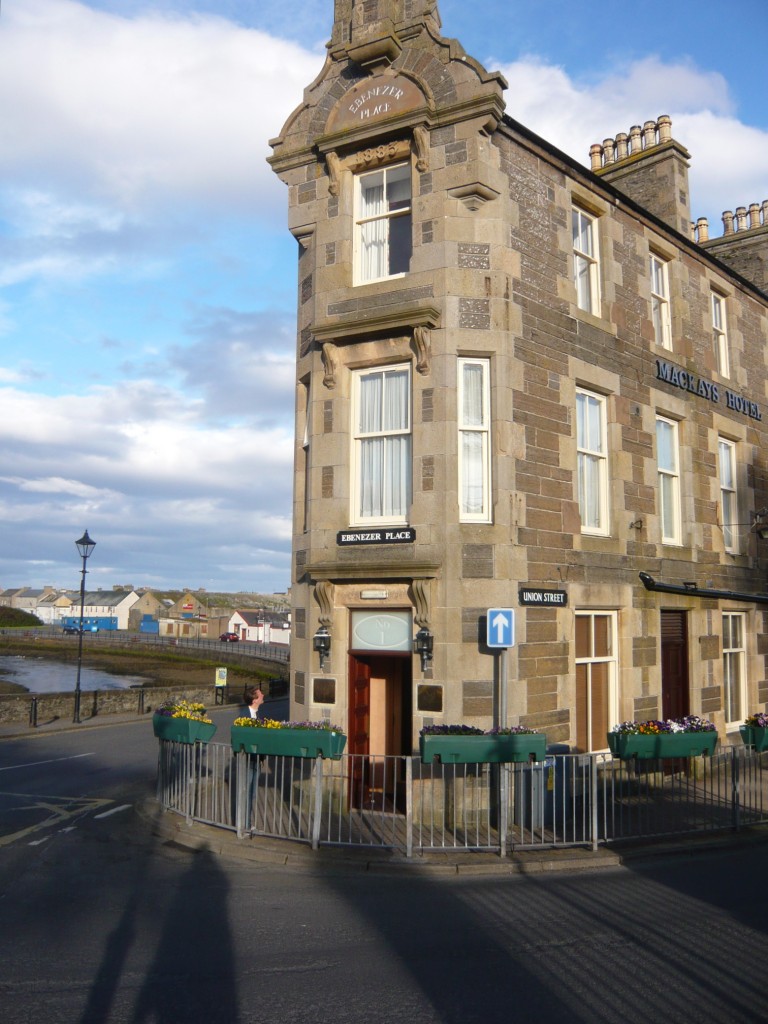
Ebenezer Place – officially the shortest street in the world. Just inside the door we had a fine dinner.
We walked the short distance over the bridge to the hotel and, informing them that we had no reservation, were shown through to the bar to wait. The restaurant had looked good as we had passed through and the fact that it was busy was a good sign.
When we were shown to our table we were just inside the door from Ebenezer Place. I felt pleased to be so close to a world record.
The menu was quite short, another good sign perhaps. I chose the crab starter, Tom something vegetarian. When they arrived it was obvious we were in for a treat if the presentation was anything to go by. The taste of the food matched up in every way.
We had eaten very well on the whole tour but, fittingly perhaps, we were ending at the apex of our gastronomic experience – the food at Mackay’s was seriously good, it was the kind that makes you want to eat slowly and savour each mouthful.
Towards the end of the dinner, after I had succeeded in resisting a pudding, the proprietor or manager approached to ask if everything had been okay. I told him that his chef was a dangerous man who could be responsible for a lot of overweight people, like me, throwing caution to the wind.
He patted his belly in sympathy and with a smile said that he already knew. He then asked how we had selected the restaurant. Tom told him of the advice given by his friend. “Oh I know that young man,” he said, “his father is the clever professor.” This was news to Tom but by now we were being accepted like locals. I hope to call back one day and I hope that the same chef is on duty.
The next morning Tom’s boiled egg was served in a kilted egg cup, in case we forgot where we were. We had three hours before our train left for Inverness, plenty of time to take in the Wick Heritage museum, another recommendation from Mark O’Groats.
En route we recce’d the station location so that we would not have a last minute panic finding it and walked down passed Mackay’s hotel towards Pulteney, the area of Wick developed in the 19th century to improve the harbour facilities on which the town’s economy largely depended.
A few hundred yards further on was the museum situated in a row of former cottages. As usual we were given a warm welcome by the museum staff and given a quick overview of the museum culminating in a video show of 1930s Wick harbour, and the herring processing while a tape recorded interview of someone describing the harbour activity was played at the same time was played.

Gutting herrings a lovely job but the women who did this became very skilled and could gut an individual herring in a second. They moved up and down the east coast of Britain following the herring catching fleets. © Wick Heritage Museum
Judging by the amount of herrings that were being caught, gutted (lovely job!) and packed with salt in barrels the whole country was eating nothing else. Now, other than kippers, I can’t remember the last time I saw herrings for sale or on a menu.
It was an interesting museum with some rooms set up to show how they would have looked in the early 20th century.
Perhaps the most eye catching exhibits though were the large photographs from the Johnson collection. The original Johnston had taken up photography in its infancy in the 1860s and started a business. His son and his grandson carried it on and amassed a collection of 100,000 photos of life in Wick over a century. Some of the negatives, perhaps half, are no longer fit to produce prints but it is still a rich resource.
A photo of a cricket team intrigued me. Of course some cricket is played in Scotland, they have a national team, but this far north? Perhaps the climate was different then?
Tom and I were immersed had had to take care to keep track of the time. Missing our train was not an option.
We left but the museum lady wanted us to see a memorial garden set in an unreconstructed bomb site from the Second World War. Wick was one of the first towns in Britain to suffer from a bombing raid and at least half the casualties had been children.
There was now no time to waste. We had to make our way back to our guesthouse, collect our bikes and pick up something for lunch. We managed it but there was not a lot of time to spare.
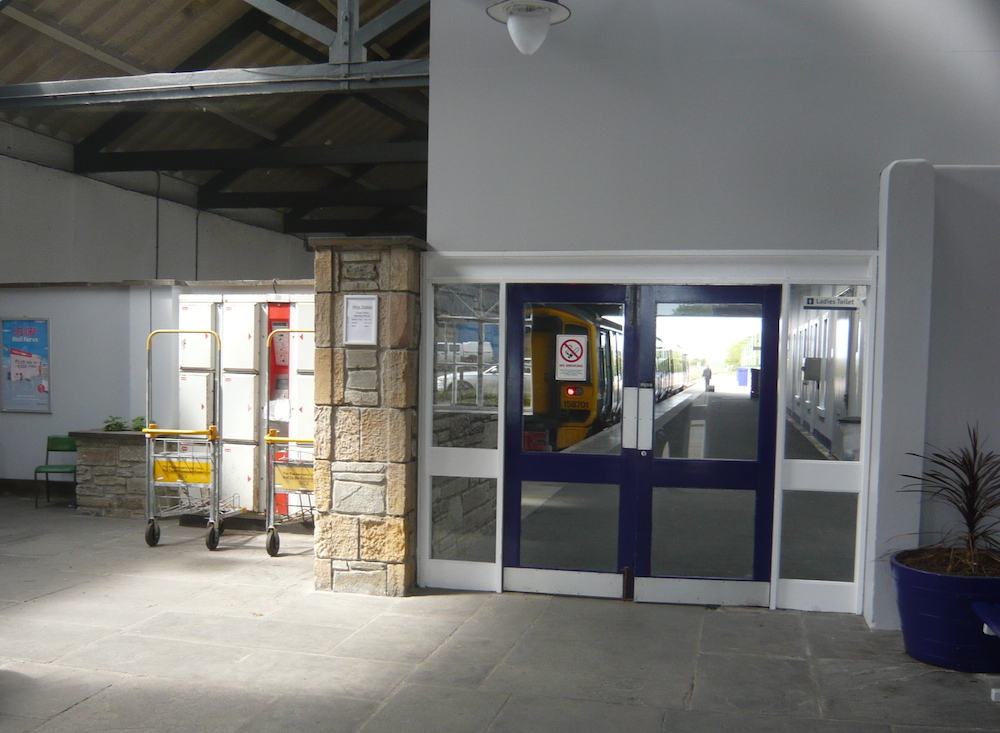
Wick Station, you can’t get lost – through the doors is the single platform and all the trains go to Inverness via Thurso.
Wick station is spic and span but it should be, it only has to deal with four trains a day and no passenger needs to ask the destination or the platform: there is only Platform 1 and all trains come from and go to Inverness, on the same route.
As usual we were challenged about having bike reservations and, as usual, a simple “Yes,” sufficed, no check was made. Having stowed the bikes we tried to find our seats: they did not seem to exist. The lady guard agreed and although the train did not seem very busy she said we could sit in first class. There was not much difference but we were happy to do so.
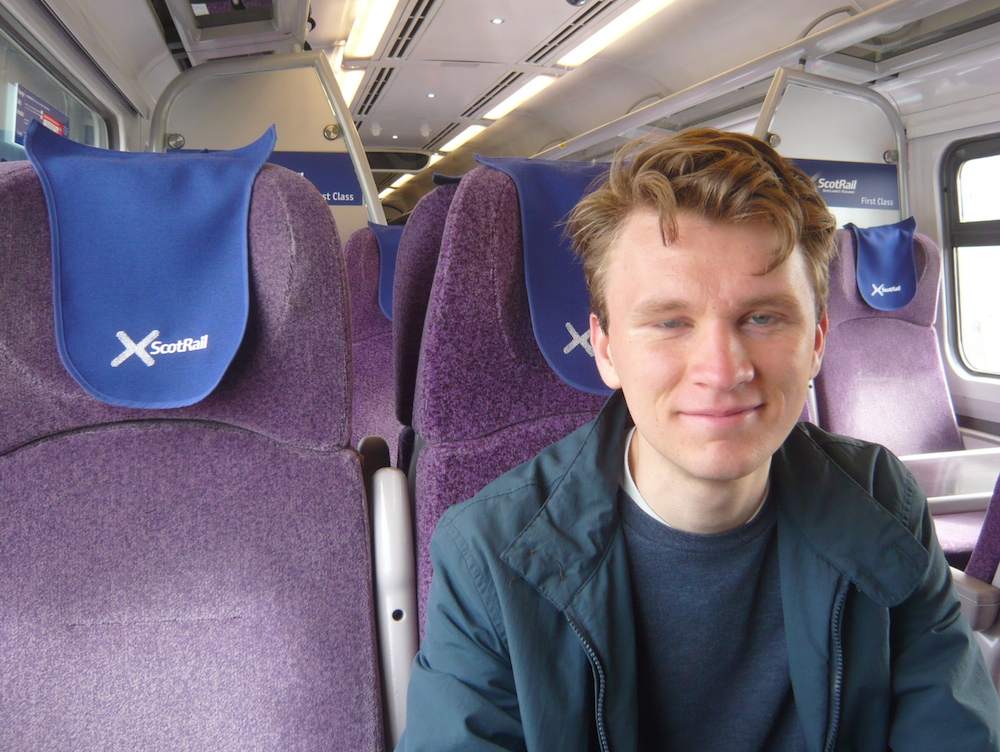
Tom looks tired but he was travelling for four hours, “first class” for around £8.50 (with young person card discount).
The journey to Wick takes over four hours and cost me about £12.80 pretty good value. Unfortunately I could not stay awake for the duration, neither could Tom so we cannot say how scenic the stretch between Forsinard and Lairg is.
At Lairg I looked at the platform, thinking of our start ten days before. I really wouldn’t have minded doing it all again.
I got busy writing and the time went quickly. Soon we were pulling in to Inverness and half an hour later Tom’s train pulled out.
I now had about three hours to kill. The lounge across the street for sleeper passengers was not yet open. I returned to the station and went into the cafe but I could not connect to the advertised “Free Wifi” so adjourned to the Royal Highland Hotel lobby, much more comfortable and 45 minutes of free wifi for the price of a much appreciated G&T.
The trip was pretty much over now, It seemed a little strange to be on my own after ten days of Tom’s company. It had been a precious time with him. He is his own man these days, His mother and I have encouraged independence in both our sons, but he was appreciative of the experience and considerate when it came to travelling with an older, less energetic companion too. I know I will look back fondly on the trip.
The north of Scotland had definitely lived up to expectations, remote, different, scenic, hospitable folk, good food and accommodation. There had not been too many cyclists but it is actually very good cycling country. If I can manage the hills then most cyclists can. Of course the weather as in Britain generally can never be guaranteed.
For those on a tighter budget there would be cheaper ways to do it, for instance hostels were available at most of our stops. The main thing is, for those capable, to give it a go.
I am already thinking of the next one…




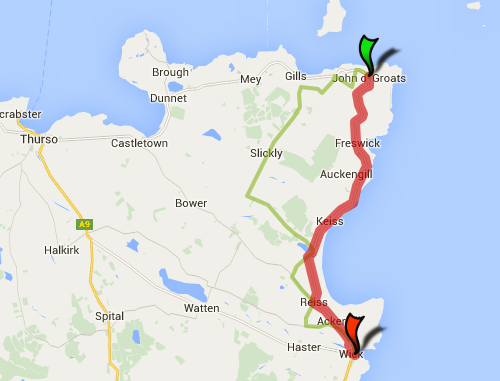
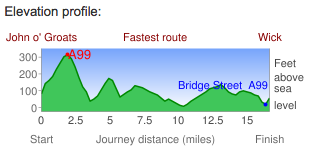
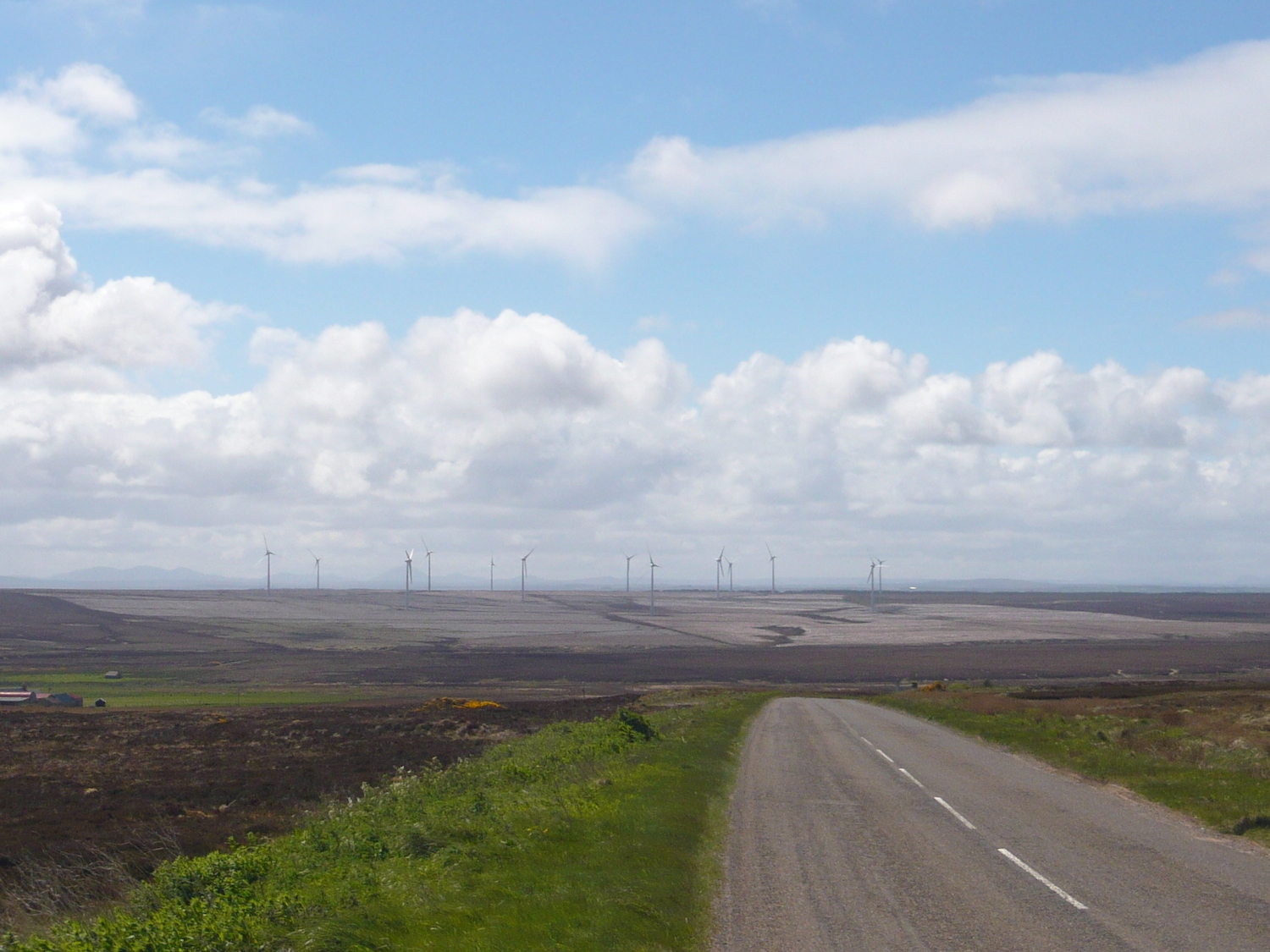

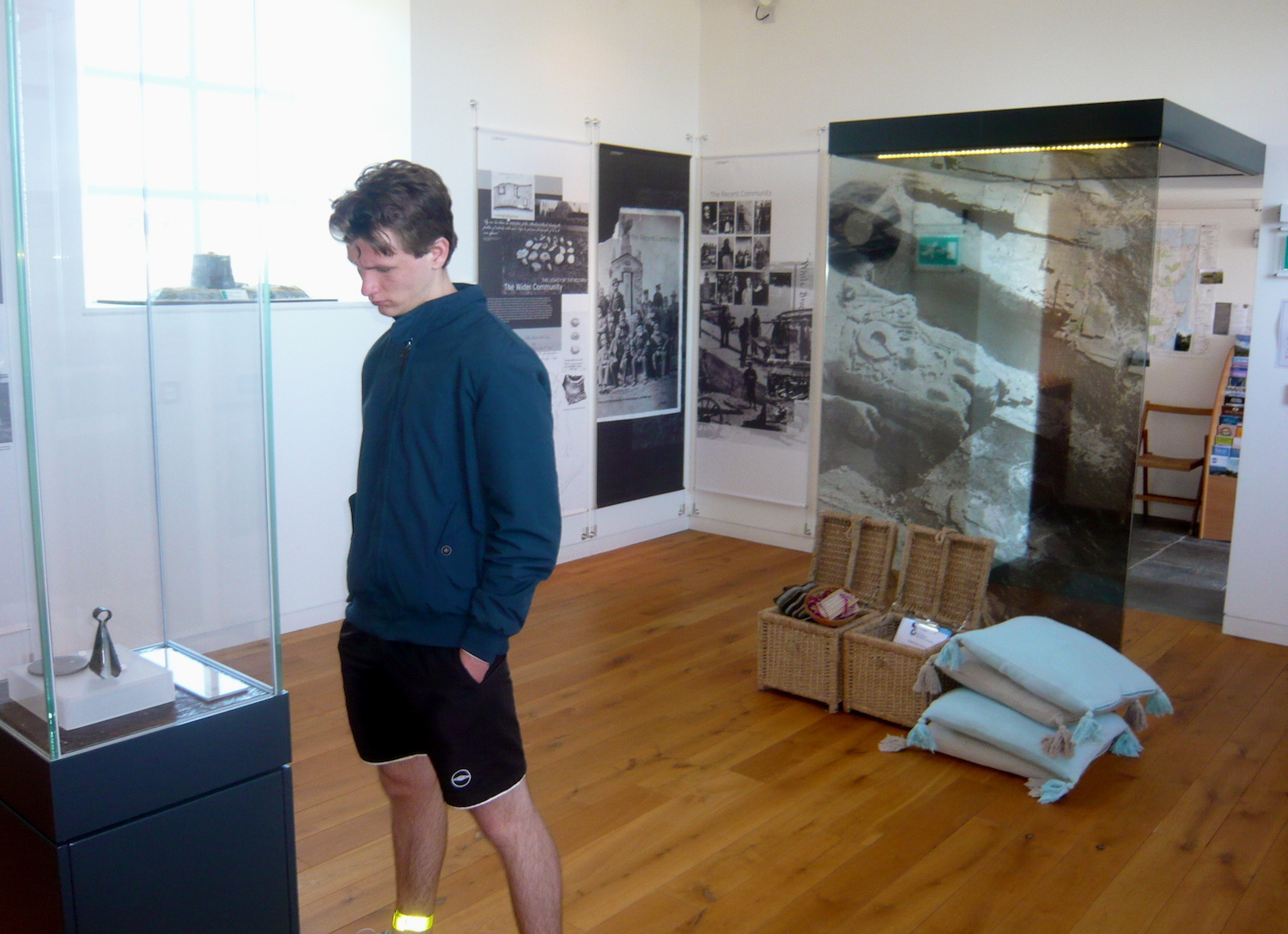
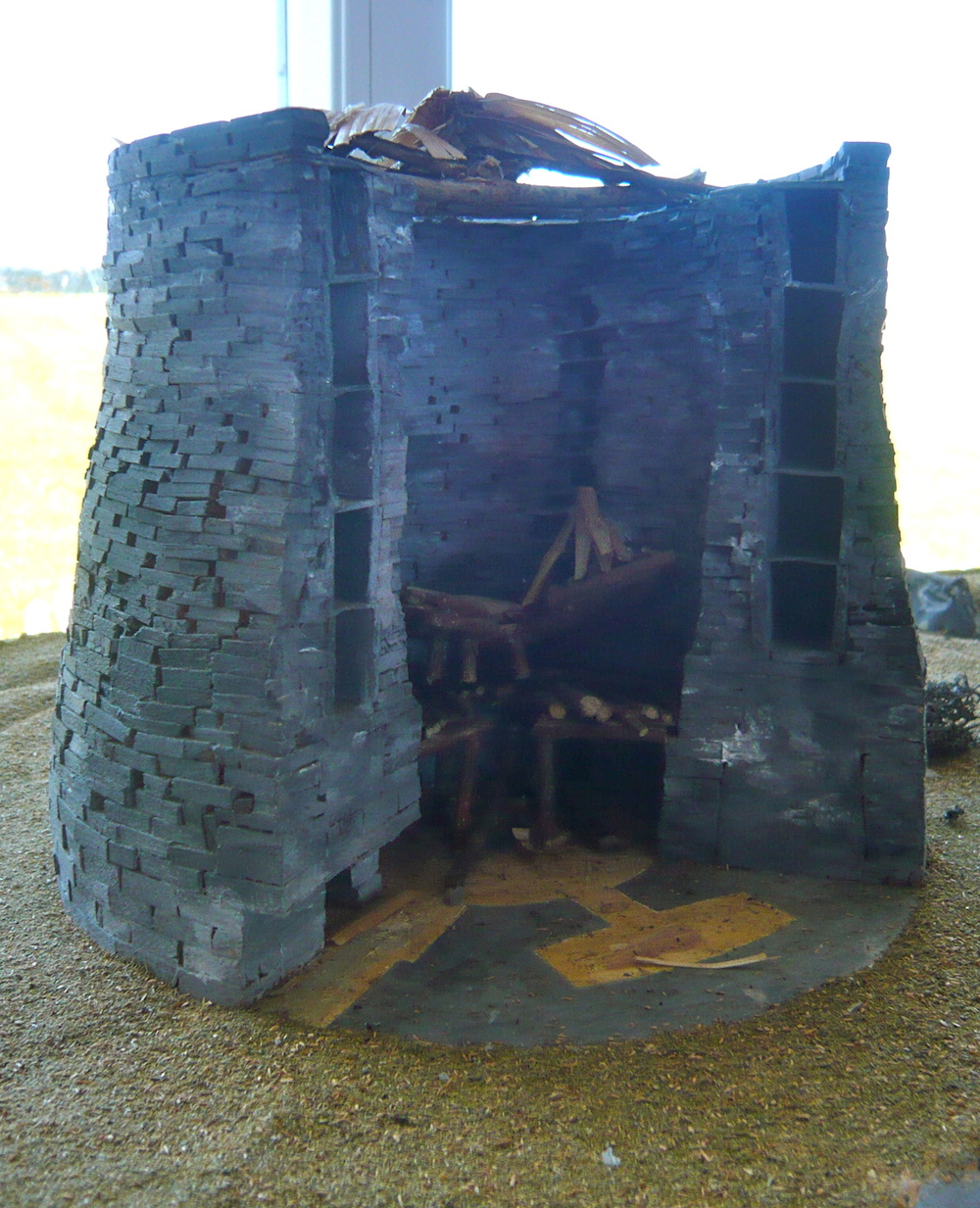
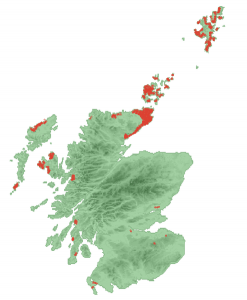
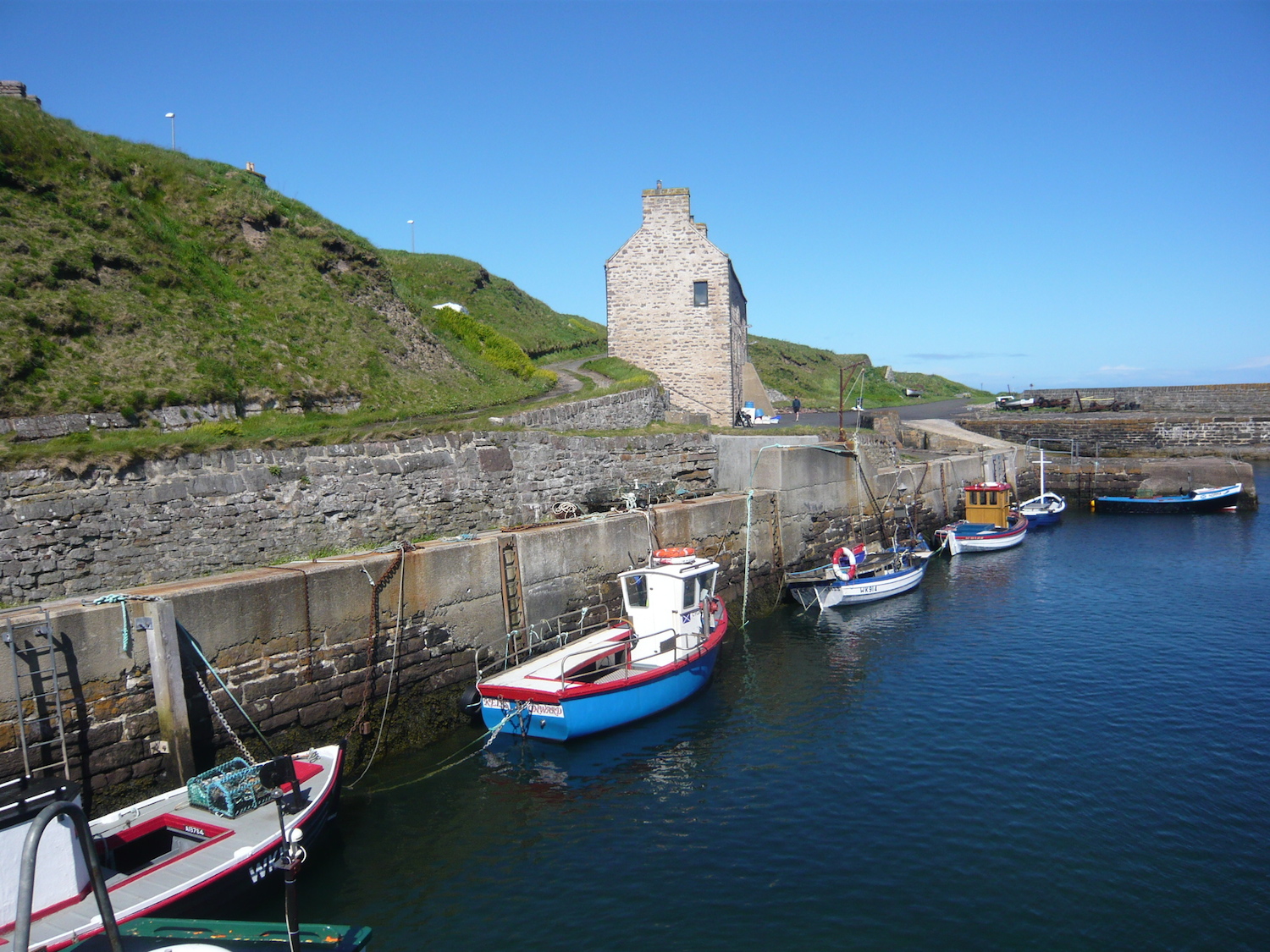
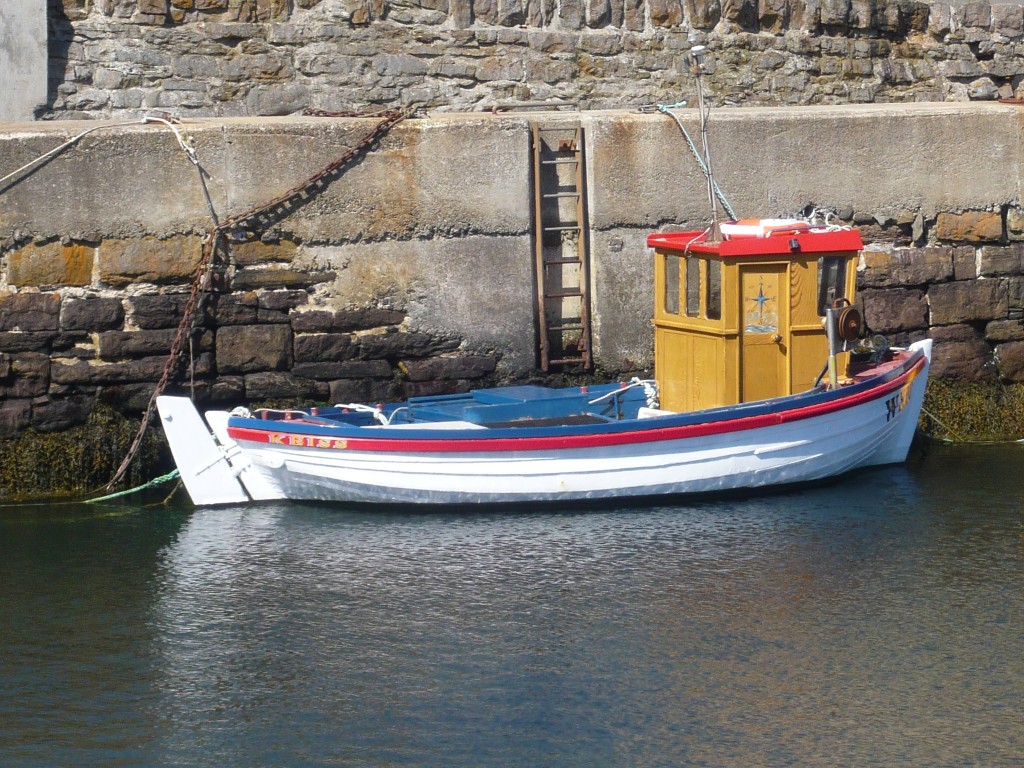


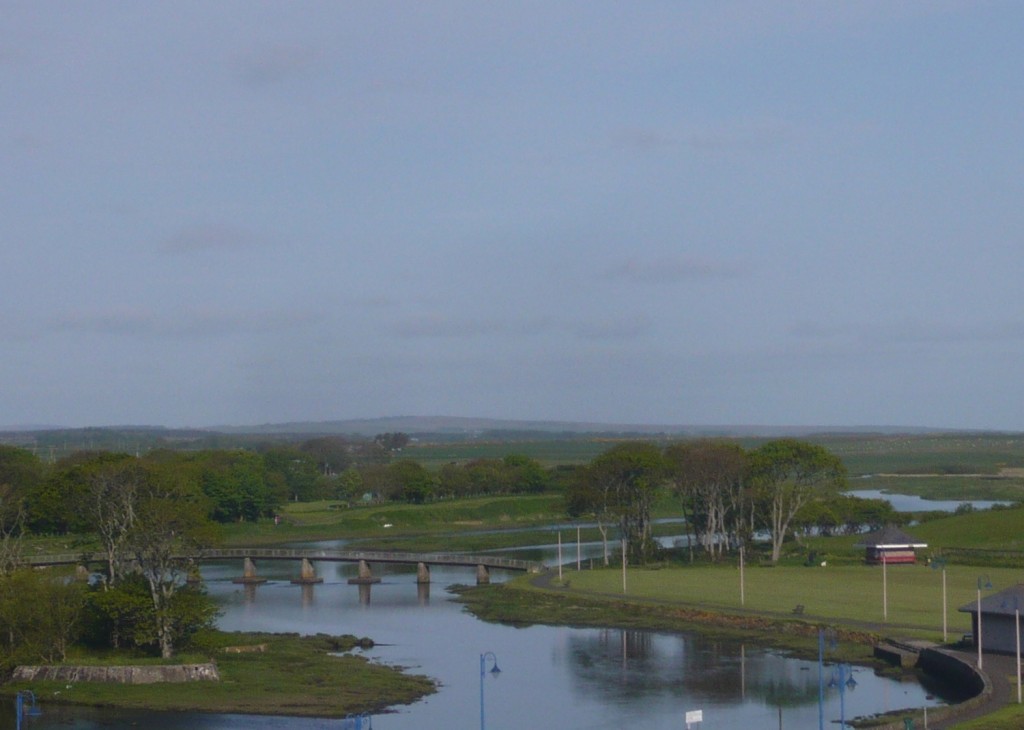
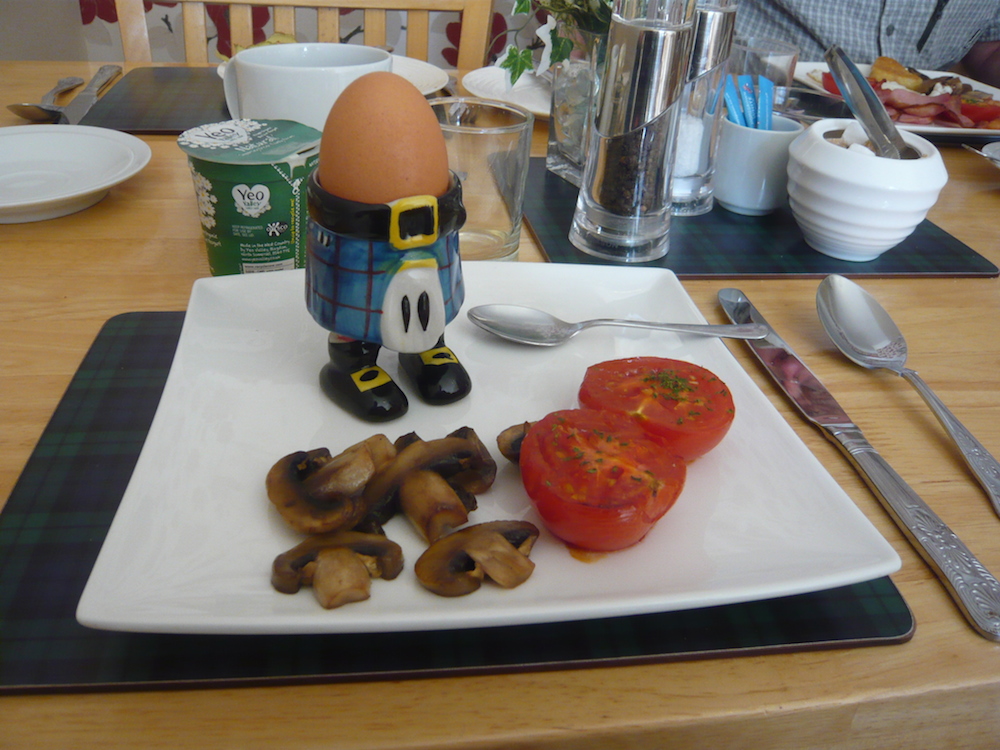











David Bailey
June 11, 2015 at 10:00 am
Thank you for taking us on a spectacular cycle ride, it was a great way for us to experience cycling up the steep Scottish hills with the cold wind and rain blowing in our faces, from the comfort of our own homes.
Your daily reports of the people you met and places you have seen were very entertaining.
We look forward to your next adventure.
Anne Harris
June 12, 2015 at 9:00 am
I have thoroughly enjoyed reading your daily reports about cycling around the north of Scotland. I neither cycle nor have I been so far north, but you have certainly whetted my appetite to visit the area, but maybe not on a bicycle!
The reports have been interesting and informative and with your wonderful sense of humour, have been most entertaining.
Thank you.
Martin Giles
June 12, 2015 at 9:26 am
Thank you for your kind comment and I am glad you were able to share our enjoyment. I would encourage you to explore this remote part of Britain and if you do I hope you get some good weather.
Of course it does not need to be done on a bike you could always jog! But the sleeper is a great way to start regardless of your eventual form of transport. The couple of times I have done it has made me feel I am making a real journey. If you book early enough it need not cost too much, especially when considering it includes a night’s accommodation.
But the sleeper is a great way to start regardless of your eventual form of transport. The couple of times I have done it has made me feel I am making a real journey. If you book early enough it need not cost too much, especially when considering it includes a night’s accommodation.